Chapter 2: Ancient Near Eastern Art
0.0(0)
0.0(0)
Card Sorting
1/80
Study Analytics
Name | Mastery | Learn | Test | Matching | Spaced |
|---|
No study sessions yet.
81 Terms
1
New cards
Sargon II
________ founded the capital at Khorsabad; the city was surrounded by a wall with seven gates.
2
New cards
Columns
________ have a bell- shaped base that is an inverted lotus blossom; the capitals are bulls or lions.
3
New cards
Shallow relief sculpture
________: an Assyrian specialty, although the lamassus are virtually three- dimensional as they project noticeably from the walls they are attached to.
4
New cards
Ancient Near East
________ is where almost everything began first: writing, cities, organized religion, organized government, laws, agriculture, bronze casting, and even the wheel.
5
New cards
Bent axis plan
________: ascending the stairs requires angular changes of direction to reach the temple.
6
New cards
Hammurabi
________ is depicted with a speaking /greeting gesture.
7
New cards
Stone
________ is rare in Mesopotamian art and contrasts greatly with the mud- brick construction of the palace.
8
New cards
Human
________- headed animal guardian figures: face of a person, ears and body of a bull.
9
New cards
Figures
________ are stoic, even while hunting lions or defeating an enemy.
10
New cards
Sumerian world
In the ________, the gods symbolized powers that were manifest in nature.
11
New cards
Lamassus
________: A Mesopotamian celestial being with a human head, bull's body, and wings.
12
New cards
Cuneiform
________: a system of writing in which the strokes are formed in a wedge or arrowhead shape.
13
New cards
Cella
________: the main room of a temple where the god is housed.
14
New cards
Anu
________: The god of the sky, the most important Sumerian deity.
15
New cards
Nudity
________: A sign of debasement; only slaves and prisoners are ________.
16
New cards
study of art history
The ________ is shaped by changing analyses based on scholarship, theories, context, and written records.
17
New cards
Humans
________ are virtually emotionless.
18
New cards
Register
________: a horizontal band, often on top of another, that tells a narrative story.
19
New cards
Whitewash
________: was used to disguise the mud appearance; hence the modern name of White Temple.
20
New cards
Apotropaic
________: having the power to ward off evil or bad luck.
21
New cards
Lapis lazuli
________: a deep- blue stone prized for its color.
22
New cards
gesture of prayer
Hands are folded in a(n) ________.
23
New cards
Lascaux
________: A network of caves near the village of Montignac, in the department of Dordogne in southwestern France.
24
New cards
Religion
________ plays a dominant role in the art of the Ancient Near East.
25
New cards
Apadana
________: an audience hall in a Persian palace.
26
New cards
Mud brick building
________ built on a colossal scale and covered with glazed tiles or cones.
27
New cards
Hypostyle hall
________: An indication of one of the many cultures that inspired the complex.
28
New cards
Sumerian art
________: It has realistic- look- ing figures acting out identifiable narratives.
29
New cards
Ancient
________ Near Eastern architecture is characterized by ziggurats and palaces that express the power of the gods and rulers.
30
New cards
Peace side
________: food brought in a procession to the banquet; musician plays the lyre; the ruler is the largest figure- he wears a kilt made of tufts of wool; may have been a victory celebration after a battle.
31
New cards
Negative space
________: empty space around an object or a person, such as the cut- out areas between a figures legs or arms of a sculpture.
32
New cards
Ground line
________: a baseline upon which figures stand.
33
New cards
Uruk
________: May be the first true city in history; the first with monumental architecture.
34
New cards
Shamash
________: Sun god, enthroned on a ziggurat, hands Hammurabi a rope, a ring, and a rod of kingship.
35
New cards
Shamashs beard
________ is fuller than Hammurabis, illustrating Shamashs greater wisdom.
36
New cards
monumental architecture
The Persians erected ________, huge audience halls, and massive subsidiary buildings for grand ceremonies that glorified their country and their rulers.
37
New cards
Ground plan
________: the map of a floor of a building.
38
New cards
hierarchy of scale
Figures are of different heights, denoting ________.
39
New cards
negative space
Figures are cut from stone, with ________ hollowed out under their arms and between their legs.
40
New cards
hierarchy of scale
Figures are constructed within stylistic conventions of the time, including the ________, registers, and stylized human forms.
41
New cards
Ancient Near East is where almost everything began first
writing, cities, organized religion, organized government, laws, agriculture, bronze casting, and even the wheel
42
New cards
Reflects extensive trading network
lapis lazuli from Afghanistan, shells from the Persian Gulf, and red limestone from India
43
New cards
Law articles are written in a formula
"If a person has done this, then that will happen to him."
44
New cards
Human-headed animal guardian figures
face of a person, ears and body of a bull
45
New cards
Appears to have five legs
when seen from the front, it seems to be standing at attention; when seen from the side, the animal seems to be walking
46
New cards
Ziggurats
The first great buildings of the ancient world; were made of baked mud, and they were tall, solid structures that dominated the flat landscape.
47
New cards
Lascaux
A network of caves near the village of Montignac, in the department of Dordogne in southwestern France.
48
New cards
Lamassus
A Mesopotamian celestial being with a human head, bull's body, and wings.
49
New cards
Cuneiform
a system of writing in which the strokes are formed in a wedge or arrowhead shape
50
New cards
Apotropaic
having the power to ward off evil or bad luck
51
New cards
Negative space
empty space around an object or a person, such as the cut-out areas between a figure’s legs or arms of a sculpture
52
New cards
Sumerian art
It has realistic-look-ing figures acting out identifiable narratives.
53
New cards
Nudity
A sign of debasement; only slaves and prisoners are nude.
54
New cards
Hierarchy of scale
a system of representation that expresses a person’s importance by the size of his or her representation in a work of art
55
New cards
Local god
An advocate for a given city in the assembly of gods.
56
New cards
Temple
Became the center point of both civic and religious pride.
57
New cards
Bent-axis plan
ascending the stairs requires angular changes of direction to reach the temple
58
New cards
Cella
the main room of a temple where the god is housed
59
New cards
Whitewash
was used to disguise the mud appearance; hence the modern name of White Temple.
60
New cards
Uruk
May be the first true city in history; the first with monumental architecture.
61
New cards
Anu
The god of the sky, the most important Sumerian deity.
62
New cards
Votive
Offered in fulfillment of a vow or a pledge
63
New cards
Ground line
a baseline upon which figures stand
64
New cards
Ground plan
the map of a floor of a building
65
New cards
Register
a horizontal band, often on top of another, that tells a narrative story
66
New cards
Lapis lazuli
a deep-blue stone prized for its color
67
New cards
Shamash
Sun god, enthroned on a ziggurat, hands Hammurabi a rope, a ring, and a rod of kingship.
68
New cards
Shamash
judge of the sky and the earth, with a tiara of four rows of horns, presents signs of royal power, the scepter and the ring, to Hammurabi.
69
New cards
Shallow relief sculpture
an Assyrian specialty, although the lamassus are virtually three-dimensional as they project noticeably from the walls they are attached to.
70
New cards
Khorsabad
Sargon II founded the capital at \____; the city was surrounded by a wall with seven gates.
71
New cards
Capital
the top element of a column
72
New cards
Apadana
an audience hall in a Persian palace
73
New cards
Audience hall (apadana)
It had 36 columns covered by a wooden roof; held thousands of people; was used for the king’s receptions; had stairways adorned with reliefs of the New Year’s festival and a procession of representatives of 23 subject nations.
74
New cards
Hypostyle hall
An indication of one of the many cultures that inspired the complex.
75
New cards
Alexander the Great
He destroyed the Apadaa; perhaps as an act of revenge for the destruction of the Acropolis in Athens.
76
New cards
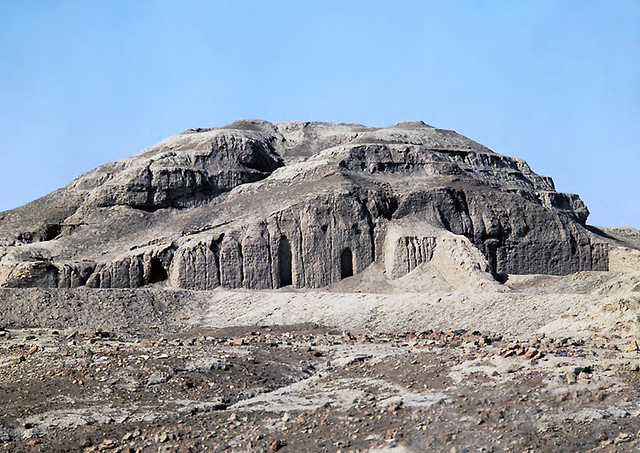
White Temple and its ziggurat
__**Details:**__
* c. 3500–3000 B.C.E
* mud brick
* Uruk (modern Warka), Iraq
__**Form**__:
* Buttresses spaced across the surface
* tapers downward so that rainwater washes off
* resembles a mountain
* Bent-axis plan
__**Function**__:
* terrace at top for rituals
* temple on top is small; access for royalty and clergy only.
* interior temple has cella and small rooms for deities
* c. 3500–3000 B.C.E
* mud brick
* Uruk (modern Warka), Iraq
__**Form**__:
* Buttresses spaced across the surface
* tapers downward so that rainwater washes off
* resembles a mountain
* Bent-axis plan
__**Function**__:
* terrace at top for rituals
* temple on top is small; access for royalty and clergy only.
* interior temple has cella and small rooms for deities
77
New cards
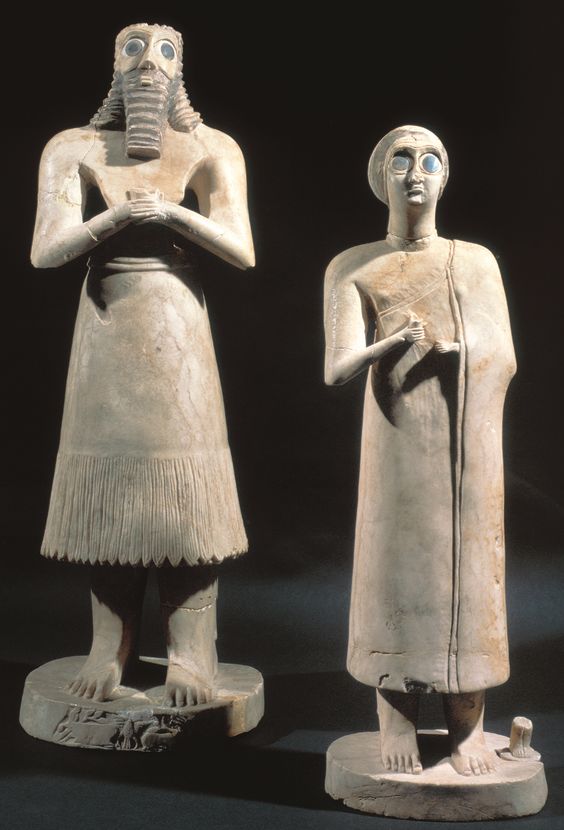
Statues of votive figures
__**Details:**__
* Square Temple at Eshnunna
* c. 2700 B.C.E.
* Gypsum inlaid with shell and black limestone
__**Form:**__
* different high figures
* huge eyes
* men are bare chested; women are dressed draped over one shoulder.
* pinkie in a spiral; chin a wedge shape; ear a double volute.
__**Function:**__
* “*It offers prayer.*“
* Represents mortals.
* Placed in temples to pray before a sculpture of god,
* Square Temple at Eshnunna
* c. 2700 B.C.E.
* Gypsum inlaid with shell and black limestone
__**Form:**__
* different high figures
* huge eyes
* men are bare chested; women are dressed draped over one shoulder.
* pinkie in a spiral; chin a wedge shape; ear a double volute.
__**Function:**__
* “*It offers prayer.*“
* Represents mortals.
* Placed in temples to pray before a sculpture of god,
78
New cards
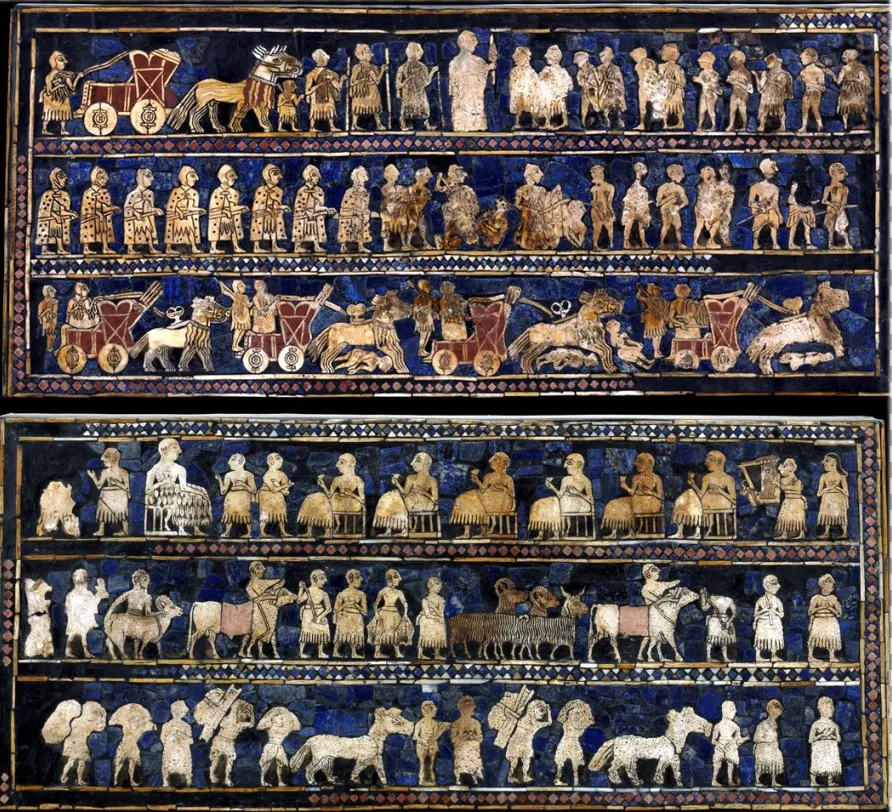
Standard of Ur
__**Details:**__
* Royal Tombs at Ur
* c. 2600–2400 B.C.E.
* Wood inlaid with shell, lapis lazuli, and red limestone
* British Museum, London
__**Forms:**__
* frontal shoulders; bodies in profile; twisted perspective.
* emphasis on eyes, brows and ears.
* organized in registers.
* read from bottom to top.
__**Content and Theories:**__
* Two sides:
* War Side
* Peace Side
* Found in a tomb at a royal cemetery.
* reflects extensive trading network
* Royal Tombs at Ur
* c. 2600–2400 B.C.E.
* Wood inlaid with shell, lapis lazuli, and red limestone
* British Museum, London
__**Forms:**__
* frontal shoulders; bodies in profile; twisted perspective.
* emphasis on eyes, brows and ears.
* organized in registers.
* read from bottom to top.
__**Content and Theories:**__
* Two sides:
* War Side
* Peace Side
* Found in a tomb at a royal cemetery.
* reflects extensive trading network
79
New cards
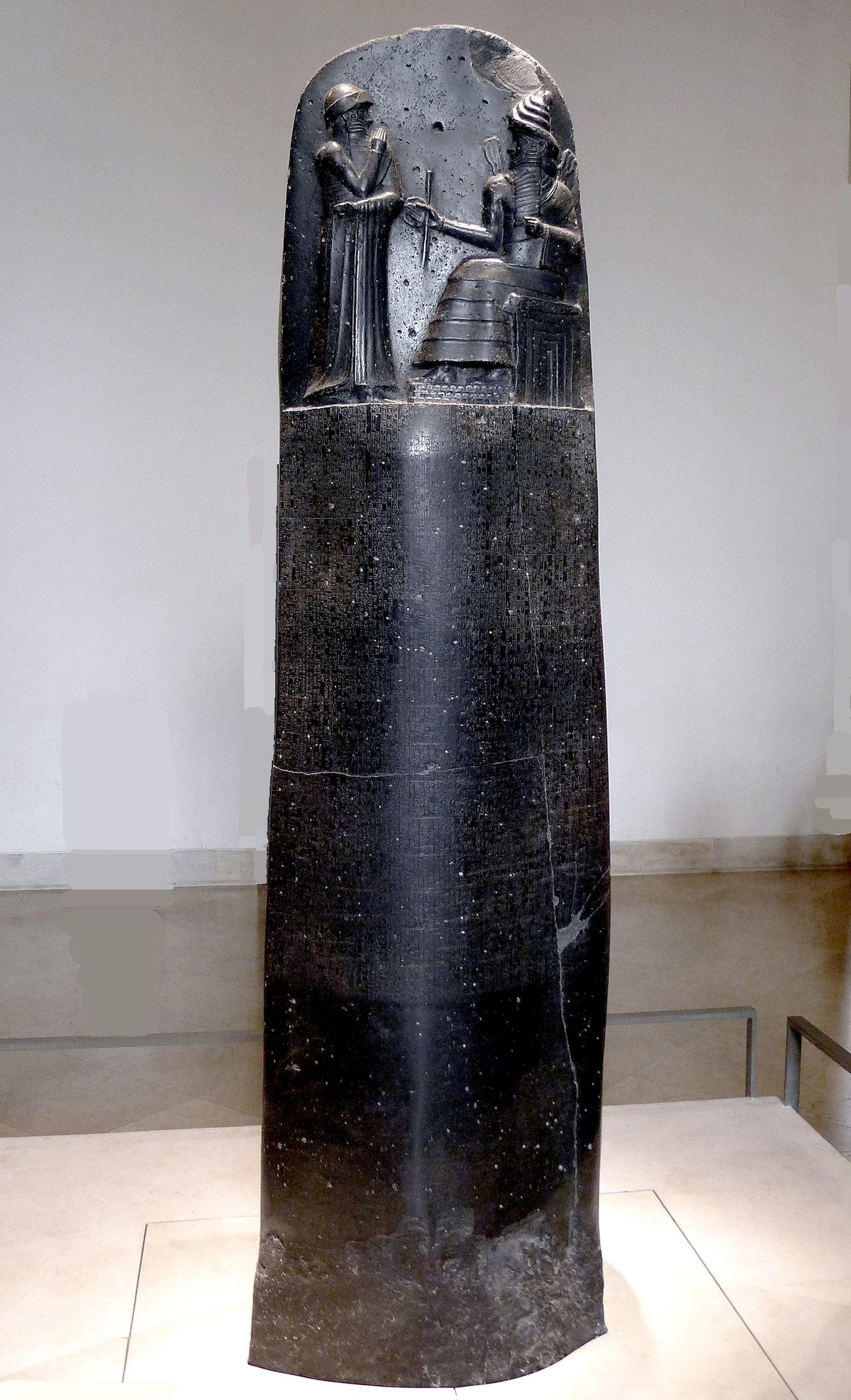
Code of Hammurabi
__**Details:**__
* Babylon (modern Iran), Susian
* c. 1792–1750 B.C.E.
* basalt
* Louvre, Paris
__**Form and Function:**__
* stele meant to be placed in an important location
* earliest law codes; 300 entries
__**Content and Context:**__
* Shamash as sun god, judge of the sky ad earth
* Shamash giving Hammurabi the laws.
* Written in cuneiform; Akkadian language
* Babylon (modern Iran), Susian
* c. 1792–1750 B.C.E.
* basalt
* Louvre, Paris
__**Form and Function:**__
* stele meant to be placed in an important location
* earliest law codes; 300 entries
__**Content and Context:**__
* Shamash as sun god, judge of the sky ad earth
* Shamash giving Hammurabi the laws.
* Written in cuneiform; Akkadian language
80
New cards
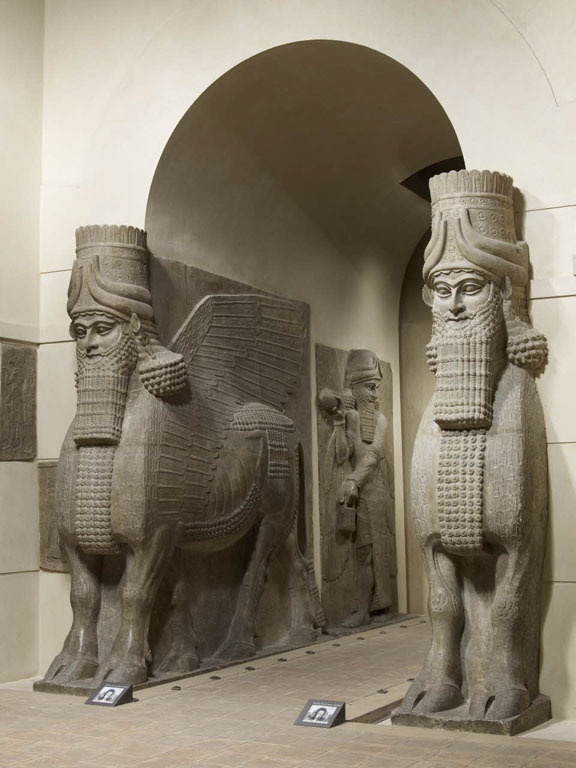
Lamassu
* __**Details:**__
* From the citadel of Sargon II, Dur Sharrukin (c. 720–705 B.C.E.)
* Alabaster
* Louvre, Paris
__**Form:**__
* human-headed animal guardian figures; winged
* has five legs; seem to be walking
* faces exude calm, serenity, and harmony.
__**Function:**__
* meant to ward off enemies both visible and invisible.
* inscriptions in cuneiform
* From the citadel of Sargon II, Dur Sharrukin (c. 720–705 B.C.E.)
* Alabaster
* Louvre, Paris
__**Form:**__
* human-headed animal guardian figures; winged
* has five legs; seem to be walking
* faces exude calm, serenity, and harmony.
__**Function:**__
* meant to ward off enemies both visible and invisible.
* inscriptions in cuneiform
81
New cards
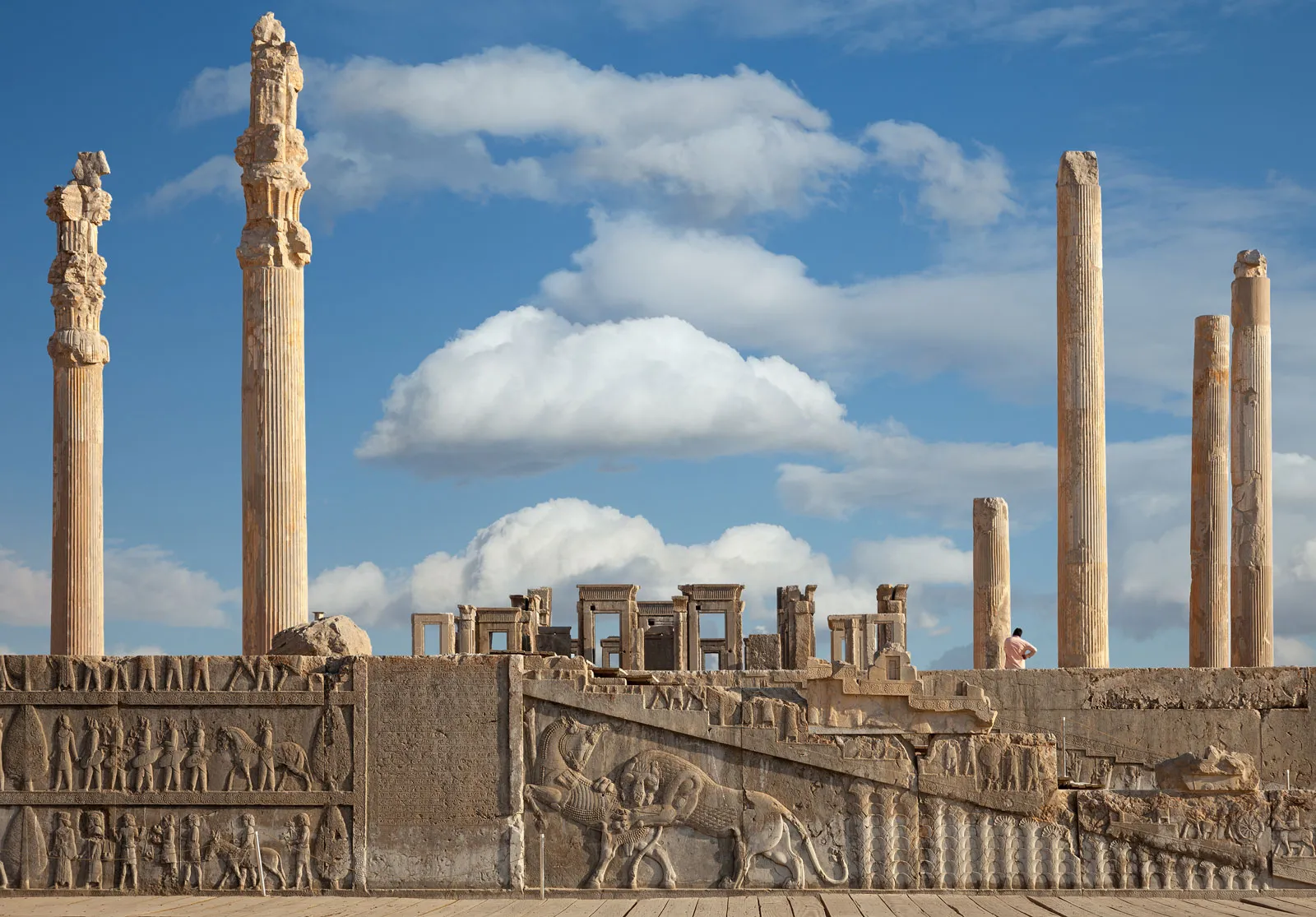
Apadana of Darius and Xerxes
__**Details:**__
* c. 520–465 B.C.E.
* limestone
* Persepolis, Iran
__**Form:**__
* artificial terraces
* bell-shaped base columns
* bulls/lions capitals
* built to dwarf the viewers
__**Function:**__
* for lavish receptions and festivals
* lamassu gates welcome visitors
__**History:**__
* Built by Darius I and Xerxes I
* Destroyed by Alexander the Great
* c. 520–465 B.C.E.
* limestone
* Persepolis, Iran
__**Form:**__
* artificial terraces
* bell-shaped base columns
* bulls/lions capitals
* built to dwarf the viewers
__**Function:**__
* for lavish receptions and festivals
* lamassu gates welcome visitors
__**History:**__
* Built by Darius I and Xerxes I
* Destroyed by Alexander the Great